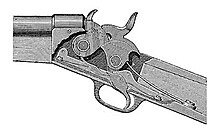| Revision as of 22:58, 5 July 2021 editLoafiewa (talk | contribs)Extended confirmed users, Pending changes reviewers, Rollbackers22,456 editsm Reverted edits by 2600:1000:B015:B377:A2D6:B932:AB5D:B369 (talk) to last version by LoafiewaTags: Rollback Reverted← Previous edit | Revision as of 00:13, 6 July 2021 edit undo174.196.197.6 (talk) I MUST UNDO MY SINSTags: Undo Reverted Non-autoconfirmed user rapidly reverting edits references removedNext edit → | ||
| Line 1: | Line 1: | ||
| {{short description|Firearm action, subclass of breech loader}} | {{short description|Firearm action, subclass of breech loader}} | ||
| ] | ] | ||
| ⚫ | A '''rolling block''' action is a form of ] where the sealing of the ] is done with a specially shaped ] able to rotate on a pin.<ref name=nfstc></ref> The breechblock is shaped like a section of a circle. | ||
| ] | |||
| ⚫ | A '''rolling |
||
| The breechblock is locked into place by the hammer, thus preventing the cartridge from moving backwards at the moment of firing. By cocking the hammer, the breechblock can be rotated freely to reload the weapon. | The breechblock is locked into place by the hammer, thus preventing the cartridge from moving backwards at the moment of firing. By cocking the hammer, the breechblock can be rotated freely to reload the weapon. | ||
| ==History== | ==History== | ||
| Due to 19th century metallurgical techniques, as with most vintage firearms produced for black powder cartridges, rifles and pistols manufactured using this action during the 19th and early 20th centuries may not be suitable for modern, high powered ammunition. Since the early 20th century |
Due to 19th century metallurgical techniques, as with most vintage firearms produced for black powder cartridges, rifles and pistols manufactured using this action during the 19th and early 20th centuries may not be suitable for modern, high powered ammunition. Since the early 20th century rolling block rifles in modern steels, suitable for smokeless powder cartridges, have been made for cartridges like the 7x57mm Mauser. | ||
| The ] is one of the most successful single shot weapons ever developed. It is a strong and simple action, very reliable, and not prone to be jammed by dirt or rough usage. It was based in part on the "split breech" action produced by Remington during the United States Civil War. That design was re-engineered by Joseph Rider |
The ] is one of the most successful single shot weapons ever developed. It is a strong and simple action, very reliable, and not prone to be jammed by dirt or rough usage. It was based in part on the "split breech" action produced by Remington during the United States Civil War. That design was re-engineered by Joseph Rider during 1865, and the first firearm based on it, the Model 1865 Remington Pistol, was offered for sale to the United States Army and Navy in 1866. While the Army turned the design down, the Navy committed to purchase 5000 pistols. | ||
| The first rifle based on this design was introduced at the Paris Exposition in 1867 and |
The first rifle based on this design was introduced at the Paris Exposition in 1867, and within a year it had become the standard military rifle of several nations, including Sweden, Norway and Denmark. | ||
| Many earlier percussion rifles and muskets were converted to rolling |
Many earlier percussion rifles and muskets were converted to rolling block designs in the interim before the development of more modern bolt-action designs. | ||
| The |
The Swedish-Norwegian ] and US ] had this action. | ||
| ==See also== | ==See also== | ||
Revision as of 00:13, 6 July 2021
Firearm action, subclass of breech loader
A rolling block action is a form of firearm action where the sealing of the breech is done with a specially shaped breechblock able to rotate on a pin. The breechblock is shaped like a section of a circle. The breechblock is locked into place by the hammer, thus preventing the cartridge from moving backwards at the moment of firing. By cocking the hammer, the breechblock can be rotated freely to reload the weapon.
History
Due to 19th century metallurgical techniques, as with most vintage firearms produced for black powder cartridges, rifles and pistols manufactured using this action during the 19th and early 20th centuries may not be suitable for modern, high powered ammunition. Since the early 20th century rolling block rifles in modern steels, suitable for smokeless powder cartridges, have been made for cartridges like the 7x57mm Mauser.
The Remington Rolling Block rifle is one of the most successful single shot weapons ever developed. It is a strong and simple action, very reliable, and not prone to be jammed by dirt or rough usage. It was based in part on the "split breech" action produced by Remington during the United States Civil War. That design was re-engineered by Joseph Rider during 1865, and the first firearm based on it, the Model 1865 Remington Pistol, was offered for sale to the United States Army and Navy in 1866. While the Army turned the design down, the Navy committed to purchase 5000 pistols.
The first rifle based on this design was introduced at the Paris Exposition in 1867, and within a year it had become the standard military rifle of several nations, including Sweden, Norway and Denmark.
Many earlier percussion rifles and muskets were converted to rolling block designs in the interim before the development of more modern bolt-action designs.
The Swedish-Norwegian Remington M1867 and US Springfield Model 1871 had this action.